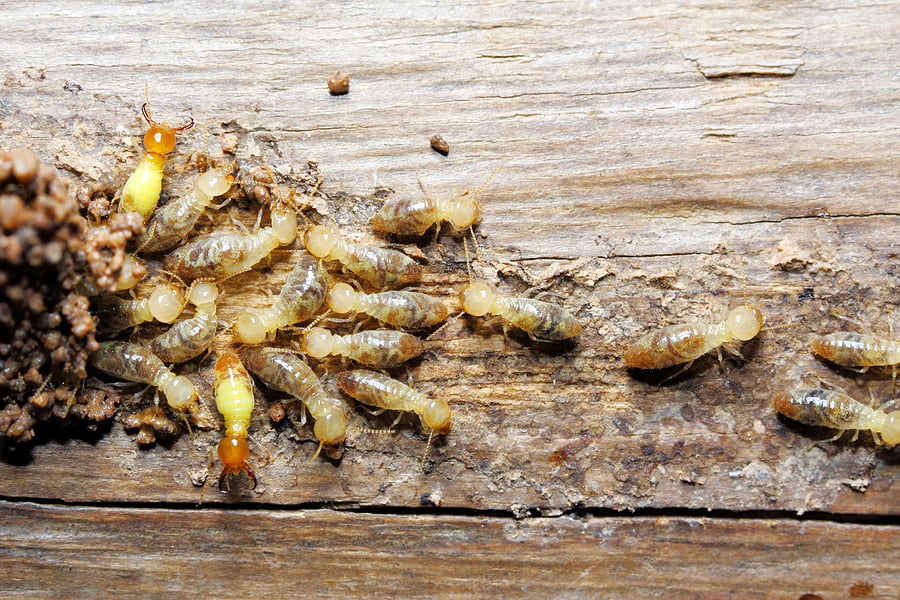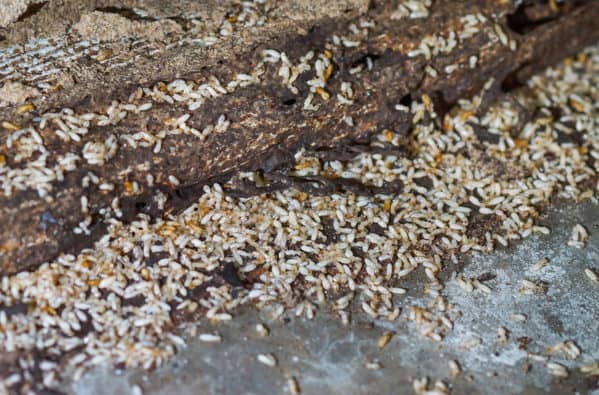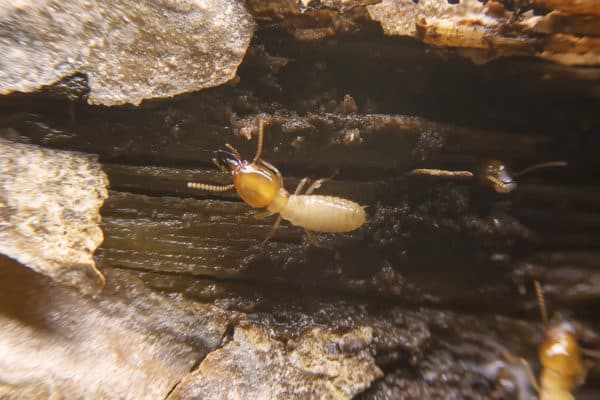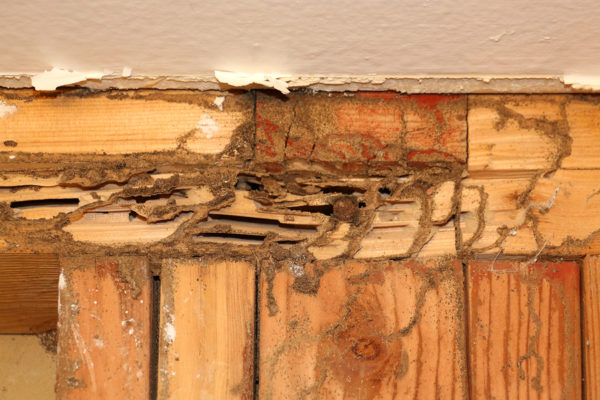READY TO GET STARTED?
REQUEST A FREE ESTIMATE
Fill out the form below or call (888) 466-7849 for a free, no-obligation estimate.

Termites cause billions of dollars in damage to homes each year. This irreparable damage can affect both the structure and the integrity of your home. It is projected that homeowners spend upwards of $2 billion on termite treatments each year. Termites eat wood from the inside out, allowing them to go undetected for long periods of time and causing significant damage before you even realize it. Oftentimes homeowners aren’t aware of the presence of termites until they discover this damage.
The most common type of termite in the United States is the subterranean termite, although drywood termites, dampwood termites and Formosan termites can also be found here. Some of the most common signs of termites in your home include termite swarms; mud tubes on or around foundations; piles of discarded wings; drooping or discolored drywall; paint that is peeling; wood that makes a hollow sound when you tap on it; squeaking floorboards; doors and windows that stick; damaged or crumbling wood; loose tile; buckling floors; and even small holes in your drywall.
There are three main methods of termite treatment and the effectiveness of each depends on the type of termite you are dealing with and the severity of the infestation. Here is a breakdown of all three, along with some termite prevention tips to help protect your home from termite damage.
Soil treatments are applied to the soil that surrounds your home to create a barrier. The first step is to dig a trench around your foundation. This soil is then treated with a termiticide and the trench is filled back in. By doing this, termites are killed as they pass through the chemicals on their way back to their nests.
Wood treatments are used to both kill existing termite colonies and also prevent future ones from starting. There are different types of wood treatments all used with varying effectiveness depending on the type of termite and the severity of the infestation. Surface sprays are treatments that are applied to the surface of wood. Injected sprays and foams are applied to the inside of wood. Borate treated wood is wood that is pretreated with a borate solution. Gas fumigation entails using fumigants that permeate throughout your entire home which disrupts the metabolism of the termites. Surface sprays and borate treated wood are usually used during construction or renovation of homes. Injections, foams, and fumigants are used after a home is built.
Bait systems are most effective at destroying termite colonies. A termite control professional will come out and install the bait stations around the outside perimeter of your home. These stations are then monitored on a regularly scheduled basis. Bait stations help ensure your home is protected from both a current infestation and a future one. The bait stations contain chemicals that termites eat and then take back to their colonies which allows it to be spread to others. This type of termite treatment is most effective with larger termite colonies.
How do you know which type of treatment is best for you? That all depends on the type of termite you are dealing with. Subterranean termites typically nest underground and enter homes where the wood structure makes direct contact with the soil. They will often squeeze through cracks in the foundation or around utility pipes through mud tubes. The best treatment for these termites is either a soil treatment or a bait station.
Drywood termites don’t require direct soil contact for survival. These termites will colonize anywhere they can find a preferred source of wood. They also don’t need as much moisture to survive like other termite species do. Drywood termites are often found in attics, dead or dying trees and shrubs, utility poles, fencing, and furniture. These termites are most effectively treated with gas fumigation or targeted termiticide.
Dampwood termites are much larger in size than their subterranean counterparts. They also have large pincers that they use to fight off predators. They typically colonize damp or decaying wood with higher moisture content like that found in logs and stumps. These termites don’t usually make their nests in the soil or build mud tubes. They are also not usually as destructive as other termite species are. The best treatment for these termites is moisture removal and termiticide application.
The best way to get a head start on termite control at home is through prevention. Most homeowners policies do not cover termite damage so keeping them away is critical to protect both your home and your wallet. You can prevent termites by:
If you suspect you have a problem with termites or you just want to get ahead with a prevention plan, contact your local pest control company who can provide you with a free analysis and set you up with a successful treatment and prevention plan going forward.
The Importance of Mosquito Treatments
How to Prepare for Snake Season

Termite infestations can cause significant (and expensive) structural damage to your home and property. What makes termites even worse is they usually cause significant damage for a long period of time without being detected.
Spring is an especially critical time for identifying and dealing with termites because that is the time of year when termites swarm to establish new colonies. These swarmers are winged adult termites that mature and fly away from their colonies to continue reproducing. Termite swarming season begins at different times for different species but all of them typically begin when the weather warms up following a significant rain event. For most species like subterranean termites, this falls in early spring. Age is also a factor in determining when termite colonies will swarm. While there is no specific age for a colony to swarm, most colonies aren’t mature enough until they are at least 3 years old.
Swarming termites often gather in areas with low-wind and diffuse light. Swarms can occur over a period of several days. Termite swarms are often confused with flying ant swarms. There are 3 major differences between termites and flying ants: antenna, wings, and body segments. Termites have straight antennae with a slight drooping look while flying ants have antenna that are bent at a 90 degree angle as they come out the side of their heads. Termite wings are basically equal in length while flying ants have front wings that are noticeably longer than their hind wings. Finally, termites have 2 body segments with straight abdomen while flying ants have 3 distinct body segments that narrow at the waist.
Odds are if you notice a termite swarm in or around your property the initial nesting site is not too far away. Termite swarms are a good indication that a termite infestation is imminent. Swarming termites also discard their wings after their new colony is established. Finding piles of discarded wings is also another sign that a new active termite colony is close by.
It is important to periodically check for signs of termites in your home to try and catch an infestation before the damage is significant (and costly).
If you notice a termite swarm this spring or any of these other signs of termites, it’s not too late to act but action should be taken sooner rather than later. With the help of a professional pest control company, you can take quick action for termite treatment while avoiding the costly headache of structural damage to your home. Whether you’ve dealt with termites in the past or just want to avoid dealing with them in the future, investing in termite protection now is always a good idea.
Where Are These Stinkbugs Coming From?
10 Common Myths About Pest Control
Keeping Wildlife Out This Spring

Termites cost homeowners billions of dollars each year in damages, treatments, and repairs. While traditional termite treatments are extremely effective at eliminating and controlling termite populations, environmentally sensitive homeowners often go in search of more green pest control options. One popular trend on the market today is orange oil treatments. Orange oil is an extract from orange rinds and is commonly used in cleaning solutions and food additives. The active ingredient in orange oil treatment is D-limonene which kills termites on contact by breaking down their exoskeleton and destroying their eggs. Orange oil treatments are the most common no-tent, no move out, organic termite control solutions.
Let’s look at some of the pros and cons of orange oil termite treatments:
Orange oil treatments are only effective against drywood termites because these pests live and colonize the wood they are infesting. They are not effective against subterranean termites as these pests live in the soil and only come up to feed on wood. Orange oil treatments will begin with a termite inspection to determine the type of termite and the extent of the infestation. Once the areas of termite damage and activity are identified, the technician will drill a hole into the wood and treat the infested areas. Orange oil is then injected into these drilled holes where it spreads throughout the wood beams via capillary action, passing through porous cells in all directions. This kills any termites and eggs on contact. This does not, however, kill any termites that don’t come in contact with the oil treatment. After treatment, the holes are then patched and painted.
In summary, orange oil does, in fact, kill termites but it is limited in its effectiveness. It is considered a secondary spot treatment as it is only effective when it is applied to areas with active infestations. Any termites that remain undetected and untreated will continue to eat, continuing the damage to your home. Because of this, multiple treatments are usually required. These treatments don’t eliminate the entire termite colony, leaving your home vulnerable. Whole structure treatment (fumigation) is a guaranteed method of completely exterminating termites from a structure. During fumigation, the whole house is treated at once. Fumigant gas is used to penetrate the walls, floor, lumber, and other surfaces where termites reside. If you suspect you have a termite issue, contact a professional pest control company who can help identify the type of termite you have, the scope of the infestation, and the best treatment options for your home.
How Much Does It Cost To Remove Animals From Your Attic?
Is Mosquito Control Needed in Winter?
Cold Weather Sends Roaches Indoors: 5 Tips to Prevent Them This Winter

Just as the weather changes with the seasons, pest activity shifts to usher in new groups of active pests. Let’s take a look at what pests are active in your area and some tips to keep them away.
The humidity and moisture that come with early summer is what helps to increase subterranean termite activity. “Swarm season” is in full effect, and this can present a problem for your home.
Summer is the biggest travel time for many. College students are coming back home, and family vacations are planned. This increases the chances of having an incident with bed bugs, and a bed bug infestation is no easy battle.
As the summer weather starts to rev up, American cockroach activity will skyrocket. While they live outdoors, if they find themselves low on food or if the weather experiences a drastic change (extreme heat or excessive rain), they will try move indoors.
Pest infestation can be costly and a major hassle. Contact a professional pest control company like Northwest for a free pest control estimate to protect your home from pests year-round.

If you’ve been outside lately you’ve probably seen signs of spring – blooming flowers, pollen that aggravates our allergies, and lots of new insects buzzing around. Another thing that spring brings is swarms – of termites! Termites are present year round but their swarming season is during spring and early summer.
Termites cause billions of dollars in damage to homeowners each year. Here in the Southeast, subterranean termites are the most common types and are particularly destructive. These insatiable eaters can damage not only wooden structures, but have even been known to cause damage to brick and concrete homes as well. Termites can invade your home through cracks and holes as small as 1/32 of an inch!
Swarms are most common in spring and summer because they are triggered by warm, humid weather. Swarming marks the start of a new termite colony. Winged termites leave their nests when they become overcrowded and their isn’t enough food to sustain them. They then take flight and actually reproduce in mid-air. The females will then shed their wings and fall back to the ground. They then go in search of a new location to start their colonies.
Swarmers don’t usually cause any damage but once they establish their new colonies their offspring can cause significant damage – usually within 2 years. If you see flying termites it can signal one of two problems:
If you see winged termites inside your home this is a good indication that you already have an established termite colony inside or that there is existing damage already.
What can you do to prevent termites from coming into your home? Check out these tips to keep the termites out!
As always, if you suspect you have termites or find signs of damage, contact a termite control company who can come in and do a thorough inspection and set you up with a comprehensive treatment plan.